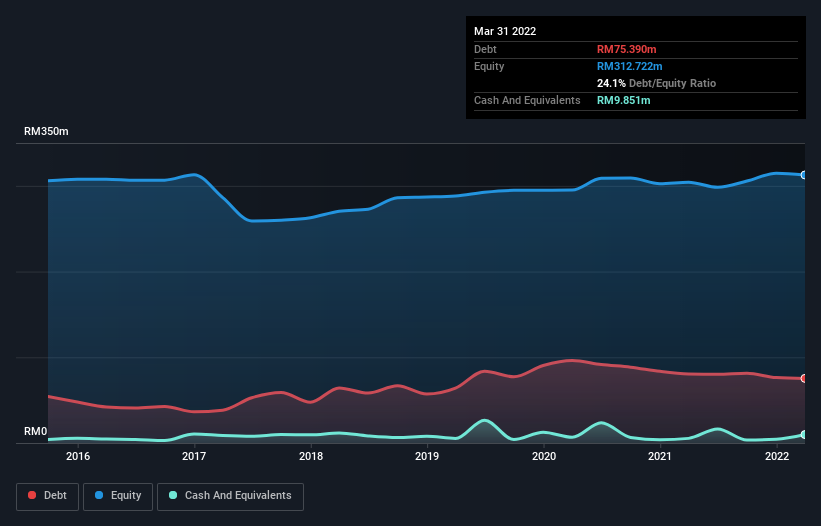Legendary fund manager Li Lu (who Charlie Munger backed) once said, 'The biggest investment risk is not the volatility of prices, but whether you will suffer a permanent loss of capital.' So it seems the smart money knows that debt - which is usually involved in bankruptcies - is a very important factor, when you assess how risky a company is. As with many other companies Seal Incorporated Berhad (KLSE:SEAL) makes use of debt. But is this debt a concern to shareholders?
When Is Debt A Problem?
Generally speaking, debt only becomes a real problem when a company can't easily pay it off, either by raising capital or with its own cash flow. Ultimately, if the company can't fulfill its legal obligations to repay debt, shareholders could walk away with nothing. However, a more frequent (but still costly) occurrence is where a company must issue shares at bargain-basement prices, permanently diluting shareholders, just to shore up its balance sheet. Of course, debt can be an important tool in businesses, particularly capital heavy businesses. When we think about a company's use of debt, we first look at cash and debt together.
View our latest analysis for Seal Berhad
How Much Debt Does Seal Berhad Carry?
You can click the graphic below for the historical numbers, but it shows that Seal Berhad had RM75.4m of debt in March 2022, down from RM80.6m, one year before. However, it does have RM9.85m in cash offsetting this, leading to net debt of about RM65.5m.

How Healthy Is Seal Berhad's Balance Sheet?
According to the last reported balance sheet, Seal Berhad had liabilities of RM57.5m due within 12 months, and liabilities of RM65.1m due beyond 12 months. On the other hand, it had cash of RM9.85m and RM154.9m worth of receivables due within a year. So it can boast RM42.2m more liquid assets than total liabilities.
This surplus strongly suggests that Seal Berhad has a rock-solid balance sheet (and the debt is of no concern whatsoever). On this view, lenders should feel as safe as the beloved of a black-belt karate master.
In order to size up a company's debt relative to its earnings, we calculate its net debt divided by its earnings before interest, tax, depreciation, and amortization (EBITDA) and its earnings before interest and tax (EBIT) divided by its interest expense (its interest cover). This way, we consider both the absolute quantum of the debt, as well as the interest rates paid on it.
Seal Berhad shareholders face the double whammy of a high net debt to EBITDA ratio (259), and fairly weak interest coverage, since EBIT is just 0.018 times the interest expense. This means we'd consider it to have a heavy debt load. One redeeming factor for Seal Berhad is that it turned last year's EBIT loss into a gain of RM37k, over the last twelve months. When analysing debt levels, the balance sheet is the obvious place to start. But it is Seal Berhad's earnings that will influence how the balance sheet holds up in the future. So when considering debt, it's definitely worth looking at the earnings trend. Click here for an interactive snapshot.
Finally, a business needs free cash flow to pay off debt; accounting profits just don't cut it. So it's worth checking how much of the earnings before interest and tax (EBIT) is backed by free cash flow. Over the last year, Seal Berhad saw substantial negative free cash flow, in total. While that may be a result of expenditure for growth, it does make the debt far more risky.
Our View
While Seal Berhad's interest cover makes us cautious about it, its track record of converting EBIT to free cash flow is no better. But at least its level of total liabilities is a gleaming silver lining to those clouds. We think that Seal Berhad's debt does make it a bit risky, after considering the aforementioned data points together. That's not necessarily a bad thing, since leverage can boost returns on equity, but it is something to be aware of. The balance sheet is clearly the area to focus on when you are analysing debt. However, not all investment risk resides within the balance sheet - far from it. To that end, you should learn about the 4 warning signs we've spotted with Seal Berhad (including 1 which makes us a bit uncomfortable) .
When all is said and done, sometimes its easier to focus on companies that don't even need debt. Readers can access a list of growth stocks with zero net debt 100% free, right now.
New: Manage All Your Stock Portfolios in One Place
We've created the ultimate portfolio companion for stock investors, and it's free.
• Connect an unlimited number of Portfolios and see your total in one currency
• Be alerted to new Warning Signs or Risks via email or mobile
• Track the Fair Value of your stocks
Have feedback on this article? Concerned about the content? Get in touch with us directly. Alternatively, email editorial-team (at) simplywallst.com.
This article by Simply Wall St is general in nature. We provide commentary based on historical data and analyst forecasts only using an unbiased methodology and our articles are not intended to be financial advice. It does not constitute a recommendation to buy or sell any stock, and does not take account of your objectives, or your financial situation. We aim to bring you long-term focused analysis driven by fundamental data. Note that our analysis may not factor in the latest price-sensitive company announcements or qualitative material. Simply Wall St has no position in any stocks mentioned.
About KLSE:SEAL
Seal Berhad
Engages in the property investment, development, and management business in Malaysia.
Adequate balance sheet with low risk.
Market Insights
Community Narratives



